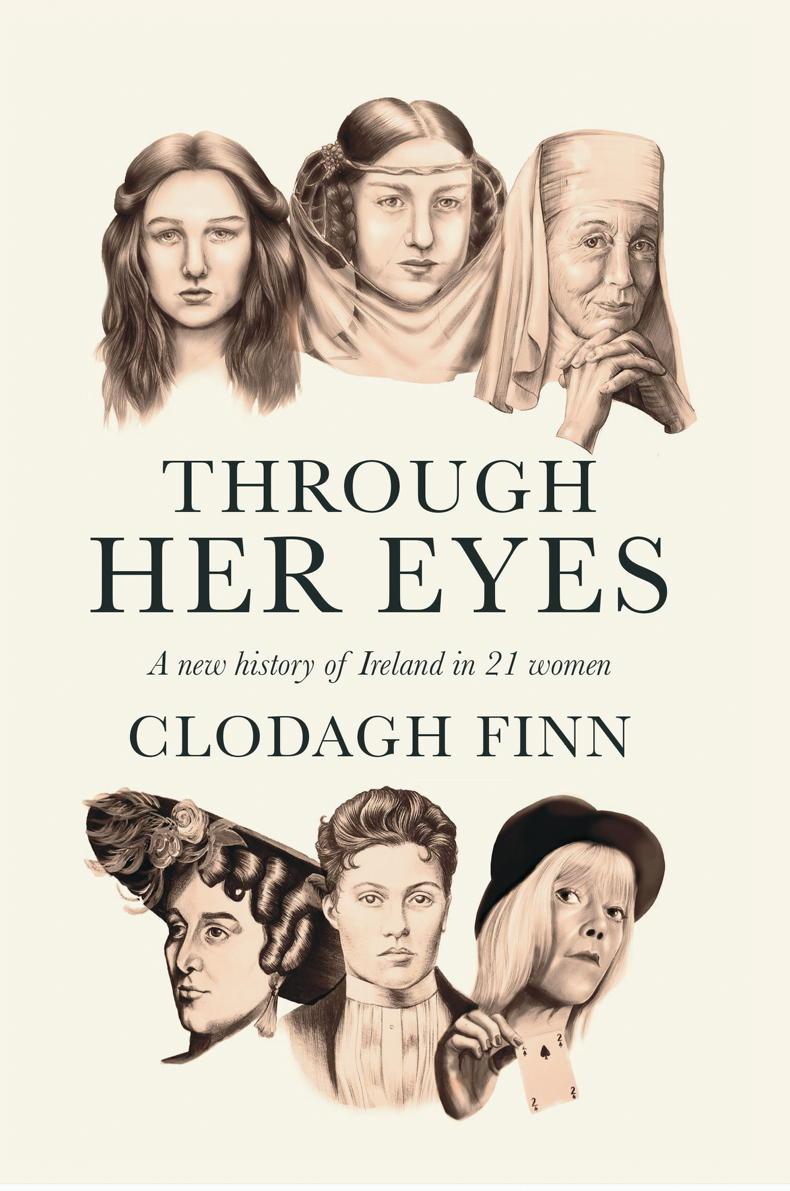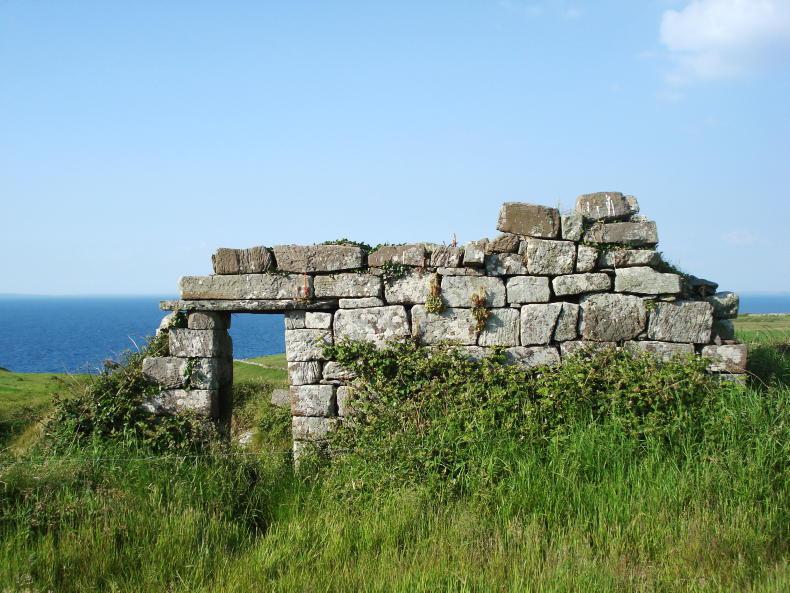Author and journalist Clodagh Finn’s book Through Her Eyes: A New History of Ireland through 21 Women takes the reader through a distinctly Irish past, but in a way few history buffs have likely experienced. Women’s history has not been well-documented, but Clodagh has been able to keep the spirits of these 21 remarkable women alive by sharing their stories through her beautifully crafted prose. She also shares miniature stories of Irish women on her Twitter feed (@FinnClodagh). In this edition of Tales from the Parish, she tells the story of St Dahalin, a nun who lived in Co Kerry in circa 500AD.

Clodagh Finn is a journalist and author of Through Her Eyes: A New History of Ireland through 21 Women.
“Let us, for a moment, imagine the fear that took hold in the convent on Kerry Head when Dahalin and her community of nuns realised that a band of raiders was fast approaching. Some say they were Vikings; those fearsome seafarers, ‘with the tumult of the ocean in their blood, who desecrated churches, plundered monasteries and burned homes in every sea-washed country in Europe’, to quote one 19th-century account. It is more likely, however, that they were not Vikings, as Dahalin is most likely to have lived at least two centuries before the Norsemen made the first incursions on Irish soil in the eighth century.
Once the enormity of what had befallen them hit home, they fell to their knees and begged Dahalin (or Daithlionn/Daithle) to restore their sight
“In any event, the threat was real and imminent when Dahalin pulled on her woollen cloak – her name means bright mantle or cloak – and went out into the night to face the marauders. As they made their way towards her convent, she struck them blind. They wandered around like drunken revellers, stretching their arms out in front of them to feel their way over the bumps and hollows of the uneven terrain on this spectacular headland.
“Once the enormity of what had befallen them hit home, they fell to their knees and begged Dahalin (or Daithlionn/Daithle) to restore their sight. She took pity on them and, after making them swear to abandon their plundering ways, led them to a well and told them to wash their eyes. They did so and, after their sight was restored, they left in peace.
“Some 15 centuries after Dahalin’s miracle, people still come to her well seeking cures for a variety of eye complaints. We can’t know if – or indeed when – this early church leader supposedly blinded the would-be intruders, but it is a simple fact that the memory of it, passed down through the generations, continues to inspire and soothe more than a millennium later. Tobar na Súl, or the Well of the Eyes, with its sweeping views of the mouth of the river Shannon and Loop Head, attracts hundreds of visitors every year.
Visit it today and you might see the pair of broken spectacles cast off and left behind in an earthen flower pot beside the well
“Pilgrims follow the ancient tradition of bathing their eyes in the water and paying rounds – circling the well three times, while saying a decade of the rosary with each rotation.
“Visit it today and you might see the pair of broken spectacles cast off and left behind in an earthen flower pot beside the well, evoking the biblical story of the lame man who threw away his crutches when Christ restored his ability to walk. In the townland of Glendahalin, or the glen of Dahalin, in north Kerry, there are many anecdotal accounts of contemporary cures, or at least partial ones, and just as many stories of modern pilgrims. One man whose sight was affected in an accident visits regularly and reports an improvement, while many others report cures. 
“Local farmer Joe Slattery says people have been coming to the well for as long as he can remember. His mother before him also witnessed a steady stream of visitors and she even saw the trout reputed to live in the well.
It was said that anyone who saw the trout would be cured: ‘People have great regard for the well. They still go and put water on their eyes and there are cures associated with it. I know of people who said they were cured of minor eye problems.’”
Through Her Eyes: A New History of Ireland through 21 Women can be purchased through Gill Books.
Author and journalist Clodagh Finn’s book Through Her Eyes: A New History of Ireland through 21 Women takes the reader through a distinctly Irish past, but in a way few history buffs have likely experienced. Women’s history has not been well-documented, but Clodagh has been able to keep the spirits of these 21 remarkable women alive by sharing their stories through her beautifully crafted prose. She also shares miniature stories of Irish women on her Twitter feed (@FinnClodagh). In this edition of Tales from the Parish, she tells the story of St Dahalin, a nun who lived in Co Kerry in circa 500AD.

Clodagh Finn is a journalist and author of Through Her Eyes: A New History of Ireland through 21 Women.
“Let us, for a moment, imagine the fear that took hold in the convent on Kerry Head when Dahalin and her community of nuns realised that a band of raiders was fast approaching. Some say they were Vikings; those fearsome seafarers, ‘with the tumult of the ocean in their blood, who desecrated churches, plundered monasteries and burned homes in every sea-washed country in Europe’, to quote one 19th-century account. It is more likely, however, that they were not Vikings, as Dahalin is most likely to have lived at least two centuries before the Norsemen made the first incursions on Irish soil in the eighth century.
Once the enormity of what had befallen them hit home, they fell to their knees and begged Dahalin (or Daithlionn/Daithle) to restore their sight
“In any event, the threat was real and imminent when Dahalin pulled on her woollen cloak – her name means bright mantle or cloak – and went out into the night to face the marauders. As they made their way towards her convent, she struck them blind. They wandered around like drunken revellers, stretching their arms out in front of them to feel their way over the bumps and hollows of the uneven terrain on this spectacular headland.
“Once the enormity of what had befallen them hit home, they fell to their knees and begged Dahalin (or Daithlionn/Daithle) to restore their sight. She took pity on them and, after making them swear to abandon their plundering ways, led them to a well and told them to wash their eyes. They did so and, after their sight was restored, they left in peace.
“Some 15 centuries after Dahalin’s miracle, people still come to her well seeking cures for a variety of eye complaints. We can’t know if – or indeed when – this early church leader supposedly blinded the would-be intruders, but it is a simple fact that the memory of it, passed down through the generations, continues to inspire and soothe more than a millennium later. Tobar na Súl, or the Well of the Eyes, with its sweeping views of the mouth of the river Shannon and Loop Head, attracts hundreds of visitors every year.
Visit it today and you might see the pair of broken spectacles cast off and left behind in an earthen flower pot beside the well
“Pilgrims follow the ancient tradition of bathing their eyes in the water and paying rounds – circling the well three times, while saying a decade of the rosary with each rotation.
“Visit it today and you might see the pair of broken spectacles cast off and left behind in an earthen flower pot beside the well, evoking the biblical story of the lame man who threw away his crutches when Christ restored his ability to walk. In the townland of Glendahalin, or the glen of Dahalin, in north Kerry, there are many anecdotal accounts of contemporary cures, or at least partial ones, and just as many stories of modern pilgrims. One man whose sight was affected in an accident visits regularly and reports an improvement, while many others report cures. 
“Local farmer Joe Slattery says people have been coming to the well for as long as he can remember. His mother before him also witnessed a steady stream of visitors and she even saw the trout reputed to live in the well.
It was said that anyone who saw the trout would be cured: ‘People have great regard for the well. They still go and put water on their eyes and there are cures associated with it. I know of people who said they were cured of minor eye problems.’”
Through Her Eyes: A New History of Ireland through 21 Women can be purchased through Gill Books.








 This is a subscriber-only article
This is a subscriber-only article










SHARING OPTIONS: